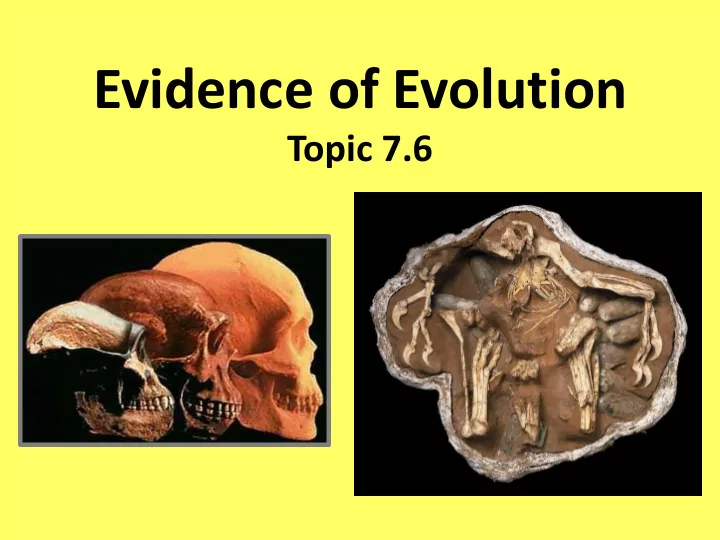

Evidence of Evolution Topic 7.6
Evolution is supported by scientific evidence from many disciplines (geographical, geological, physical, biochemical, and mathematical data). EVO – 1.M.1, 1.N.1, 1.N.2
Scientific Evidence of Evolution • Geographical – Distribution of living things on Earth • Geological – Examples include fossils • Physical – Comparative Morphology/Embryology • Biochemical – Comparison of DNA nucleotide and protein sequences • Mathematical – Radiometric Dating of Fossils or Molecular Clocks
Phylogeny • Scientific evidence is used to determine evolutionary relationships between organisms and the evolutionary history of an organism ( phylogeny ) • Relationships and history are depicted in diagrams known as phylogenetic trees or cladograms Tree of Life Web Project (Click on this link explore the collaborative effort to discover the phylogeny of every species on Earth)
Phylogenetic Tree
Geographic Evidence • Distribution of living things around the globe provides information about the past history of living things and the surface of the Earth ( biogeography ) • Scientists can used biogeography to understand the evolution of a species
Evolution of the Camel Family
Madagascar’s Endemic Species (Click on this link to read about Madagascar’s endemic species) • Geographic isolation may lead to the evolution of endemic species • Endemic species exist in only one geographic region and are found nowhere else in the world, usually located in biodiversity hotspots
Geological Evidence • Examples include fossils and iron oxides in rock • Earth core samples show environmental change over time
Fossils • Fossils provide a record of early life and evolutionary history • Fossils provide physical evidence of an organism that lived long ago
Fossil Dating • Fossils can be dated by a variety of methods, including: – Determining the age of the rocks where a fossil is found – Using the rate of decay of isotopes including carbon-14 – Geographical data
Fossil Dating • Determine the age of a fossil by finding the age of the rock where the fossil is found (513-512 mya)
Relative Dating • Determines the relative order of past events • Law of Superposition – a vertical set of strata (layers of rock) is a chronological record of the geological history of that strata • Youngest layers are on top and the oldest are on the bottom
Fossil Dating • Determine the absolute age of a fossil by looking at the rate of decay of isotopes (radiometric dating) • Carbon-14: half life of 5730 years • Uranium-238: half life of 4.56 billion years
Carbon Dating
Physical Evidence Physical evidence of evolution includes: • Comparative Anatomy 1. Morphological Homologies 2. Vestigial Structures 3. Analogous Structures • Comparative Embryology
Homologous Structures • Homologous structures are structural features that originated in a common ancestor • Similar in structure but may differ in function
Homologous Structures • Morphological homologies represent features shared by common ancestry
Vestigial Structures • Vestigial structures are remnants of functional structures that were once useful in the ancestor of the modern day organism • Evidence of common ancestry
Analogous Structures (This 2 minute video explains the difference between homologous and analogous) • Also known as homoplasies • Structures that shares a common function, but are not similar in structure • Demonstrates that species evolved independently of one another - not from a common ancestor • Result from convergent evolution
Comparative Embryology • Comparison of embryos and embryonic development • Evidence of common ancestry
Biochemical Evidence • A comparison of DNA nucleotide sequences and/or protein amino acid sequences provides evidence of evolution and common ancestry • Scientists analyze notable genetic similarities and differences
Sequence Alignment • DNA, RNA, and amino acid sequences can be aligned with software to examine similarities and differences between species
Biochemical Evidence • Genetic code is universal – All organisms use the same genetic code to operate their cell(s) – Believed to be established early in the history of life – Evidence of common ancestry of all life forms • Some biochemical pathways are universal – Similar processes for photosynthesis and respiration between organisms
Universal Genetic Code
Mathematical Evidence (This 2 minute video explains the molecular clock) • Molecular clocks use mutations to estimate evolutionary time and divergence from a common ancestor • Assume that genetic mutations occur at a relatively constant rate
Many fundamental molecular and cellular features and processes are conserved across all organisms. EVO – 2.B.2
Molecular and Cellular Evidence • DNA and RNA are carriers of genetic information • Genetic code is shared by all modern living systems • Conservation of metabolic pathways
Conservation of Metabolic Pathways • The metabolic pathway glycolysis is evidence for the relatedness of all domains of life (Eukarya, Bacteria, Archaea) • Glycolysis is the MOST widespread metabolic pathway among Earth’s organisms • Suggests glycolysis evolved very early in the history of life
Common Ancestry Topic 7.7
Structural evidence indicates common ancestry of all eukaryotes. EVO – 2.B.2
Structural Evidence Supports the Relatedness of All Eukaryotes • All eukaryotic organisms share common structures such as: – Membrane-bound organelles – Linear chromosomes – Genes that contain introns
Linear Chromosomes • All eukaryotes are composed of cells with linear chromosomes • Prokaryotes contain a single, circular chromosome
Genes and Introns • Eukaryotic genes contain non-coding regions called introns which are removed during RNA processing • Prokaryotic genes DO NOT contain introns
Continuing Evolution Topic 7.8
All species have evolved and populations continue to evolve. EVO – 3.A.1, 3.A.2
Continuous Change in the Fossil Record • The fossil record provides physical evidence of change over time and continuous change
Evolution Continues to Occur • Evolution of resistance to - antibiotics - pesticides and herbicides - chemotherapy drugs
Pesticide Resistance
Emergent Diseases • Pathogens (viruses, bacteria, fungi, protozoa, worms) evolve and cause emergent diseases • Emergent diseases are infections that have recently appeared within a population or those whose incidence or geographic range is rapidly increasing
Recommend
More recommend